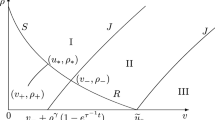Abstract
In this paper, we establish and analyze a traffic flow model which describes the formation and dynamics of traffic jams. It consists of a pressureless gas dynamics system under a maximal constraint on the density and is derived through a singular limit of the Aw-Rascle model. From this analysis, we deduce the particular dynamical behavior of clusters (or traffic jams), defined as intervals where the density limit is reached. An existence result for a generic class of initial data is proved by means of an approximation of the solution by a sequence of clusters. Finally, numerical simulations are produced.
Similar content being viewed by others
References
Aw A., Klar A., Materne A., Rascle M. (2002) Derivation of continuum traffic flow models from microscopic follow-the-leader models. SIAM J. Appl. Math. 63:259–278
Aw A., Rascle M. (2000) Resurrection of second order models of traffic flow. SIAM J. Appl. Math. 60:916–938
Berthelin F. (2002) Existence and weak stability for a two-phase model with unilateral constraint. Math. Models Methods Appl. Sci. 12:249–272
Berthelin F., Bouchut F. (2003) Weak solutions for a hyperbolic systems with unilateral constraint and mass loss. Ann. Inst. H. Poincare Anal. Non Linéaire 20:975–997
Bouchut, F.: On zero pressure gas dynamics. In: (Ed. Perthame, B.), Advances in kinetic theory and computing, World Scientific (1994)
Bouchut F., Brenier Y., Cortes J., Ripoll J.F. (2000) A hierachy of models for two-phase flows. J. Nonlinear Sci. 10:639–660
Bouchut F., James F. (1999) Duality solutions for pressureless gases, monotone scalar conservation laws, and uniqueness. Comm. Partial Differential Equations 24:2173–2189
Brenier Y., Grenier E. (1998) Sticky particles and scalar conservation laws. SIAM J. Numer. Anal. 35:2317–2328
Colombo R.M. (2002) A 2 × 2 hyperbolic traffic flow model Traffic Hav modelling and simulation. Math. Comp. Modelling 35:683–688
Dafermos, C.: Hyperbolic conservation laws in continuum physics. Springer-Verlag, 1999
Daganzo C. (1995) Requiem for second order fluid approximations of traffic flow. Transp. Res. B 29B:277–286
E. W., Rykov, Y.G., Sinai, Y.G. (1996) Generalized variational principles, global weak solutions and behavior with random initial data for systems of conservation laws arising in adhesion particle dynamics. Comm. Math. Phys. 177, 349–380
Gazis D.C., Herman R., Rothery R. (1961) Nonlinear follow-the-leader models of traffic flow. Oper. Res. 9:545–567
Grenier E. (1995) Existence globale pour le système des gaz sans pression. C. R. Math. Acad. Sci. Paris 321:171–174
Klar, A., Wegener, R.: Traffic flow: models and numerics. In: Modeling and Computational Methods for Kinetic Equations, Birkhäuser, Boston, 219–259 (2004)
Klar A., Wegener R. (1997) Enskog-like kinetic models for vehicular traffic. J. Stat. Phys. 87:91–114
Lighthill, M.J., Whitham, J.B.: On kinematic waves. I: flow movement in long rivers. II: A theory of traffic flow on long crowded roads. Proc. R. Soc. Lond. Sec A 229, Math. Phys. Eng. Sci. 281–345 (1955)
Nagel K., Schreckenberg M. (1992) A cellular automaton model for freeway traffic. J. Physique 2:2221–2229
Nelson P. (1995) A kinetic model of vehicular traffic and its associated bimodal equilibrium solutions. Transport. Theory Statist. Phys. 24:383–409
Paveri-Fontana S.L. (1975) On Boltzmann-like treatments for traffic flow. Transportation Res. 9:225–235
Payne, H.J.: Models of Freeway Traffic and Control. In: Mathematical Models of Public Systems, Simulation Council Proc. 1, (1971)
Payne H.J. (1979) FREFLO: A macroscopic simulation model of freeway traffic. Transportation Research Record 722:68–75
Prigogine I., Herman R (1971) Kinetic theory of vehicular traffic. American Elsevier Publishing Co, New-York
Serre, D.: Systems of conservation laws 1 & 2. Cambridge University Press, 1999 and 2000
Smoller, J.: Shock waves and reaction-diffusion equations. Springer-Verlag, 1983
Temple B. (1983) Systems of conservation laws with coinciding shock and rarefaction curves. Contemp. Math. 17:143–151
Zhang M. (2002) A non-equilibrium traffic model devoid of gas-like behavior. Transportation Res. B 36:275–290
Author information
Authors and Affiliations
Corresponding author
Additional information
Communicated by C. M. Dafermos
Rights and permissions
About this article
Cite this article
Berthelin, F., Degond, P., Delitala, M. et al. A Model for the Formation and Evolution of Traffic Jams. Arch Rational Mech Anal 187, 185–220 (2008). https://doi.org/10.1007/s00205-007-0061-9
Received:
Accepted:
Published:
Issue Date:
DOI: https://doi.org/10.1007/s00205-007-0061-9




